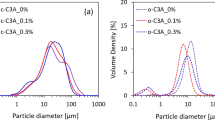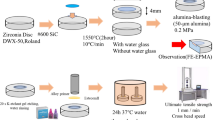Abstract
The reaction of strontium oxide powder with poly(acrylic acid) has been studied both alone and within glass–ionomer cements. Reaction was found to be slow and the strontium-carboxylate structure was found to be partially covalent in character, as determined by Fourier transform infrared spectroscopy (FTIR). These are similar to the structures formed by calcium in glass–ionomer cements, but are different from typical monomeric strontium carboxylates, which tend to be purely ionic. Strontium oxide powder introduced in two types of glass–ionomer cements, slowed down the setting reaction at both 21 °C and 37 °C, but at low levels (5 wt %), increased the compressive strength in both cement formulations studied. However, at higher levels, it was found to decrease the compressive strength. This study confirms the view that strontium is a cement-forming ion; but concludes that, except at very low levels, strontium oxide powder does not improve the properties of glass–ionomer cements.
Similar content being viewed by others
References
G. J. Mount, “Colour atlas of glass-ionomer cements”, Second edition, (Martin Dunitz, London, 1994).
R. G. Hill and A. D. Wilson, Glass Technol. 29 (1988) 150.
R. D. Shannon, Acta Crystallogr. A 32 (1976) 751.
E. A. Wasson, Clin. Mater. 12 (1993) 181.
J. A. Williams, R. Billington and G. J. Pearson, Br. Dent. J. 172 (1992) 279.
E. A. Wasson and J. W. Nicholson, Clin. Mater. 15 (1994) 169.
J. W. Nicholson, S. Hawkins and J. E. Smith, J. Mater. Sci; Mater. in Med. 4 (1993) 418.
R. K. Bansal, U. S. Tewari and P. Singh et.al., J. Oral Rehab. 22 (1995) 533.
A. D. Wilson and J. W. Nicholson, “Acid-Base cements” (The University Press, Cambridge, 1993).
International Organization for Standardization, Specification for dental water based cements, ISO 9917: 1991.
L. J. Bellamy, “The infrared spectra of complex molecules” (Chapman & Hall, London, 1975).
G. B. Deacon and R. J. Phillips, Co-ord. Chem. Rev. 33 (1980) 227.
R. C. Mehrotra and R. Bohra, “Metal carboxylates” (Academic Press, New York, 1983).
J. W. Nicholson and A. D. Wilson, Brit. Polym. J. 19 (1987) 67.
M. A. Mesubi, J. Mol. Structure 81 (1982) 61.
A. I. Grigorov, Russ. J. Inorg. Chem. 8 (1963) 409. Quoted in reference 12.
S. Crisp, M. A. Pringuer, D. Wardleworth and A. D. Wilson, J. Dent. Res. 53 (1974) 1414.
J. W. Nicholson, P. J. Brookman, O. M. Lacy and A. D. Wilson, J. Dent. Res. 67 (1988) 1450.
S. Matsuya, T. Maeda and M. Ohta, J. Dent. Res. 75 (1996) 1920.
R. Hanna and G.-J. Su, J. Am. Ceram. Soc. 47 (1964) 597.
Author information
Authors and Affiliations
Rights and permissions
About this article
Cite this article
Deb, S., Nicholson, J.W. The effect of strontium oxide in glass–ionomer cements. Journal of Materials Science: Materials in Medicine 10, 471–474 (1999). https://doi.org/10.1023/A:1008944924726
Issue Date:
DOI: https://doi.org/10.1023/A:1008944924726




